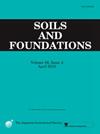Enhanced microstructural analysis of black cotton soil stabilized through rice husk ash integration
IF 3.3
2区 工程技术
Q2 ENGINEERING, GEOLOGICAL
引用次数: 0
Abstract
Black cotton soil (BCS) poses significant complexities in geotechnical applications due to its swelling and shrinkage behavior. It causes significant economic losses globally due to reconstruction and rehabilitation efforts. Reliable soil reinforcement techniques are, therefore, essential to mitigate the deleterious effects of expansive BCS and to ensure the long-term stability of the structures built upon them. The present study explores the application of rice husk ash (RHA) to BCS using nitrogen (N2) gas adsorption techniques such as Brunauer–Emmett–Teller (BET), Langmuir, and adsorption isotherm analyses. These techniques are based on the principle that N2 gas is adsorbed onto the reactive surface sites. The surface of BCS is considered reactive due to its high clay content and the presence of montmorillonite. With the addition of RHA, pozzolanic reactions progress, leading to the development of cementitious phases such as calcium silicate hydrate (C-S-H), which gradually fill these reactive surface sites, leading to a decrease in the material’s gas adsorption capacity. This reduction in N2 gas adsorption provides a measurable indication of pozzolanic activity, allowing for a more detailed microstructural assessment of stabilized soil systems. A sharp reduction in N2 gas adsorption was observed in BET, Langmuir, and adsorption isotherm analyses at 6 % RHA content, conducted on 28-day cured Unconfined compressive strength (UCS)-tested samples. BET results showed a reduction in adsorption from 0.0635 mg/g for untreated BCS to 0.0385 mg/g at 6 % RHA concentration. This 6 % RHA content also corresponds with peak mechanical performance observed in UCS, California bearing ratio (CBR), indirect tensile strength (ITS), and cone penetration test (CPT), highlighting a strong correlation between microstructural improvement and engineering behavior. The UCS of untreated BCS (183 kPa) increased to a maximum of 819 kPa after 7 days and 1370 kPa after 28 days of curing, confirming 6 % RHA as the optimum dosage.
稻壳灰分固化黑棉土的微观结构分析
黑棉土由于其膨胀和收缩特性,在岩土工程应用中具有很大的复杂性。由于重建和恢复工作,它在全球造成重大经济损失。因此,可靠的土壤加固技术对于减轻膨胀BCS的有害影响并确保在其上建造的结构的长期稳定性至关重要。本研究利用brunauer - emmet - teller (BET)、Langmuir等氮气吸附技术和吸附等温线分析,探讨了稻壳灰(RHA)在BCS中的应用。这些技术是基于N2气体被吸附到反应表面的原理。由于其高粘土含量和蒙脱土的存在,BCS的表面被认为是活性的。随着RHA的加入,火山灰反应的进行,导致水合硅酸钙(C-S-H)等胶凝相的发展,这些胶凝相逐渐填充这些反应表面位点,导致材料的气体吸附能力下降。N2气体吸附的减少为火山灰活性提供了可测量的指示,从而可以对稳定土壤系统进行更详细的微观结构评估。在固化28天的无侧限抗压强度(UCS)测试样品中,BET、Langmuir和6% RHA含量的吸附等温线分析显示,N2气体吸附急剧减少。BET结果表明,在6% RHA浓度下,未处理BCS的吸附量从0.0635 mg/g降至0.0385 mg/g。6%的RHA含量也与UCS、加州承载比(CBR)、间接抗拉强度(ITS)和锥体穿透测试(CPT)中观察到的峰值力学性能相对应,突出了微观结构改善与工程行为之间的强烈相关性。未处理BCS (183 kPa)的UCS在固化7天后达到最大值819 kPa,固化28天后达到最大值1370 kPa,确定6% RHA为最佳剂量。
本文章由计算机程序翻译,如有差异,请以英文原文为准。
求助全文
约1分钟内获得全文
求助全文
来源期刊

Soils and Foundations
工程技术-地球科学综合
CiteScore
6.40
自引率
8.10%
发文量
99
审稿时长
5 months
期刊介绍:
Soils and Foundations is one of the leading journals in the field of soil mechanics and geotechnical engineering. It is the official journal of the Japanese Geotechnical Society (JGS)., The journal publishes a variety of original research paper, technical reports, technical notes, as well as the state-of-the-art reports upon invitation by the Editor, in the fields of soil and rock mechanics, geotechnical engineering, and environmental geotechnics. Since the publication of Volume 1, No.1 issue in June 1960, Soils and Foundations will celebrate the 60th anniversary in the year of 2020.
Soils and Foundations welcomes theoretical as well as practical work associated with the aforementioned field(s). Case studies that describe the original and interdisciplinary work applicable to geotechnical engineering are particularly encouraged. Discussions to each of the published articles are also welcomed in order to provide an avenue in which opinions of peers may be fed back or exchanged. In providing latest expertise on a specific topic, one issue out of six per year on average was allocated to include selected papers from the International Symposia which were held in Japan as well as overseas.
 求助内容:
求助内容: 应助结果提醒方式:
应助结果提醒方式:


